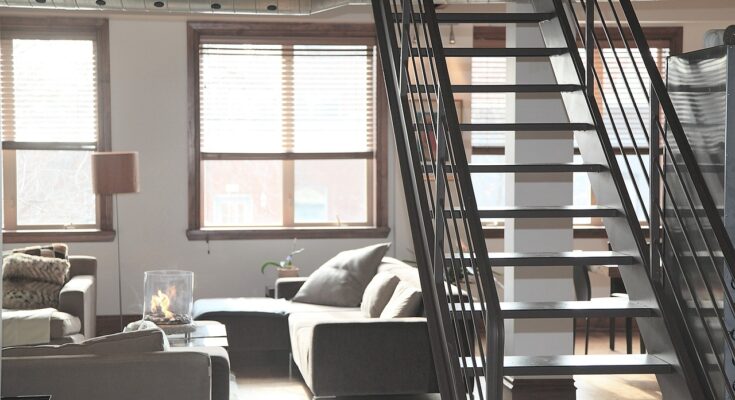Stairs design can be a somewhat daunting responsibility, especially in today’s compact homes. Small homes require stairs that are functional, safe, and visually appealing but do not consume much of the square footage. Fortunately, smart design and design innovation, which involve the use of stairs, can be more than just a feature in an architectural landscape; they can also be space savers in a limited environment. This article discusses different and effective solutions for designing stairs in a small house.
1. Spiral Stairs
Spiral stairs are a classic for small houses and are an exemplary solution for creating small living spaces. Small and round in design, they also require little area, and therefore, most homeowners use them to link various floors in their homes without crowding. These stairs are perfect for constraining spaces or more loft-like environments.
Benefits:
One advantage over conventional staircases is that they occupy considerably less floor area.
A modern feature that also brings a point of interest to the view.
It comes in various material types, such as wooden, metal, and glass, to suit various home preferences.
Tip:
Choose a steel-based metallic design with slender railing rods so the overall interior concept remains as open and not confined as possible, even in such locales.
2. Floating Stairs
Comparatively, floating stairs or cantilever stairs give the appearance of living weightlessness and sleekness. They connect to a wall with hidden connections, thus, these don’t require biological pillars or balustrades in some models.
Benefits:
Achieves a professional minimalistic look that helps optimize space on the favorites bar.
It permits easier lighting of rooms and makes rooms appear larger than they are.
Serves also as a decorative sculpture.
Tip:
Integrate floating stairs with under-stair storage to improve productivity in tiny homes.
3. Storage-Integrated Stairs
In finding practical applications for stairs in a small home, one of the most strategic uses is Bolstering space for storage below or even in the stairway. In every corner of the house, this design works and is used for storing books, shoes, or other household items.
Ideas for Storage-Integrated Stairs:
Storage boxes or shelves at the side that will pull out as the stairs move up.
Built-in shelves for books, decorations, or plants below the stairs.
Storage solutions to hide things from sight.
Tip:
You can adapt different compartments, such as a home office or pantry, by integrating them into the staircase to reduce its complexity.
4. Ladder-Style Stairs
Ladder-style stairs occupy the least space in the area called the rise. Although they are not conventional stairs, they are ideal for lofts, mezzanines, or even attic rooms in micro houses.
Benefits:
Uses the least amount of space.
Using and installation costs are relatively cheap.
Gives more fun and natural ambiance to homes.

Tip:
Use contrasting colors or materials for the treads to enhance visibility and ensure safety.
6. Small U or L-shaped stairs are also preferred to save space.
This type of staircase is the basic model and can also be applied to tiny houses using thinner steps and sharper turns of the stairs. These staircases are best placed where they form part of a wall or where a corner can cap off the design.
Benefits:
A chief advantage of transforming a staircase is that it gives the stair layout a standard and familiar design.
It can also have landing platforms to work as safety features.
Most suitable for tiny 2-unit flat houses or apartments.
Tip:
It will blend L-shaped stairs with glass balustrades to keep the flow as open as possible in small rooms.
7. Semiautomatic or Automated Stairs
Some garages or other auxiliary spaces, such as attics or lofts, still need infrequent access; the use of folding or retractable stairs makes sense. You can draw up or put away these staircases when they are not needed.
Benefits:
Compared to pallet jacks, pallet jacks take up no floor space when folded, meaning they don’t use any floor space.
It suits situations where the spaces of the building are used only sporadically.
It provides them with a discreet, modern-day solution.
Tip:
Construct folding stairs using light substances and have incorporated operations that can be operated automatically.
8. Glass and Open Stair Designs
For small homes, stairs made of glass or an open frame would help reduce the feeling of crowdedness in the house. This arrangement of the actual floor creates visions of glass treads or open risers, which means that light can pass through, bringing in the aspect of smooth visibility.
Benefits:
Improves the provisions of natural illumination.
It saves space and reduces visual confusion, where the sizes of furniture pieces and interior spaces are limited.
Improves the design with elegance and combines the present with the future.
Tip:
To establish the identity of the design, it is best to incorporate wooden or steel decorations into the glass stairs.
Final Thoughts
Small homes stairs design can be done without a homeowner having to settle. As can be seen, with some imagination and choosing appropriate, compact solutions, stairs can become helpful and beautiful or even be used for multiple purposes. From modern spiral stairs to floating staircases or stairs with a lot of storage space built into them, there are numerous options available in household staircases. If well-designed, stairs are among the most striking features, and this need could complement the beauty of a tiny home.
Also read about: Selection of the Perfect Stairlift


One Comment on “Stairs Design for Small Homes”